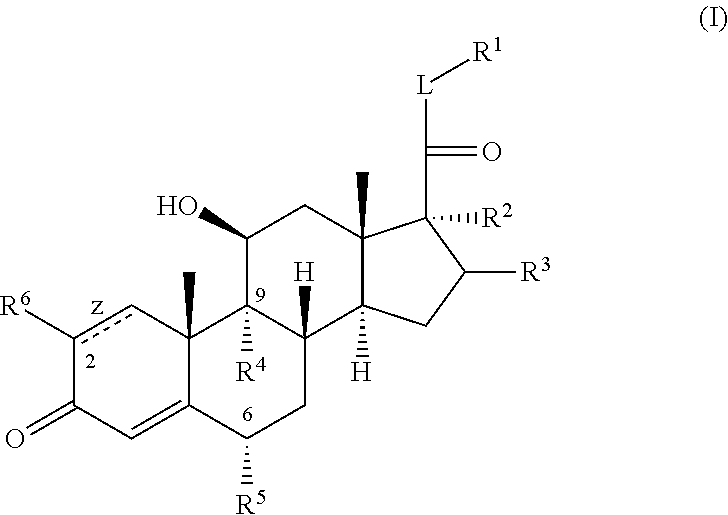C20-c21 substituted glucocorticoid receptor agonists
- Summary
- Abstract
- Description
- Claims
- Application Information
AI Technical Summary
Benefits of technology
Problems solved by technology
Method used
Image
Examples
example 1
[1038]Step 1
[1039]A solution of the hydrocortisone 11 (5 g, 0.0138 mol) in dichloromethane (100 mL) was treated with diisopropylethylamine (8.9 g, 0.0691 mol) at 0° C. The reaction mixture was allowed to stir for 5 minutes; methane sulfonyl chloride (2.9 g, 0.02486 mol) was added drop wise at 0° C. and allowed to stir for 4-6 hours. The reaction mixture was diluted with dichloromethane, taken in to a separatory funnel and washed with dilute HCl, water, brine and dried over anhydrous sodium sulfate. Removal of the solvent gave the crude mesylate, which was purified by using column chromatography using dichloromethane and methanol (20:1) to afford the mesylate 12 as a crystalline solid. Yield=5.5 g (82%).
[1040]Step 2
[1041]A solution of the hydrocortisone-21-mesylate 12 (0.25 g, 0.000568 mol), 2-mercaptoquinoline (0.132 g, 0.000909 mol) and potassium carbonate (0.392 g, 0.00284 mmol) in acetone (10 ml) was refluxed for 12 hours. The reaction mixture was cooled to room temperature, filt...
example 2
[1042]Step 1
[1043]To a solution of the hydrocortisone-21-mesylate 12 (10 g, 0.0227 mol) in dichloromethane was added diisopropylethyamine (14.65 g, 0.114 mol) dropwise at 0° C. The reaction mixture was then treated with the 2-mercaptobenzothiazole (5.69 g, 0.0343 mol) and stirring was continued for 6-12 hours at room temperature. The reaction mixture was diluted with dichloromethane, washed with dilute hydrochloric acid, water, and brine, dried over anhydrous sodium sulfate. Filtration and removal of solvent afforded the crude product, which was purified by using column chromatography or preparative thin layer chromatography using dichloromethane and methanol solvent system (20:1) to afford compound 12a as a white crystalline solid. Yield=8.6 g (73%).
[1044]Step 2
[1045]To a solution of the DMAP (4.58 g, 0.0375 mol) in methylene chloride (20 ml) was added dropwise furoyl chloride (0.67 g, 0.00516 mol) at 0° C. The mixture was then treated with a solution of compound 12a (2.4 g, 0.0046...
example 3
[1046]
[1047]Compound 13 has been described in the literature (e.g., Fu, X. et al., Organic Process Research and Development 2001, 5, 376-382) and is commercially available.
[1048]Compound 13 was converted to benzothiazole 14 using procedures of step 1 of Example 1, followed by the procedures of steps 1 and 2 of Example 2.
[1049]To a solution of the epoxy compound 14 (5.0 g, 0.00813 mol) while stirring in acetic acid (15 mL) was added at 0° C. a solution of HCl in acetic acid (1M, 16.26 mL) and stirred for 3-5 hours while warming to room temperature. Water was added to the reaction mixture; the precipitate was collected by filtration, dried and recrystallized from dichloromethane and methanol to afford the compound Product. Yield=4.6 g (87%) MH+ 652
PUM
| Property | Measurement | Unit |
|---|---|---|
| Structure | aaaaa | aaaaa |
Abstract
Description
Claims
Application Information
 Login to View More
Login to View More - R&D
- Intellectual Property
- Life Sciences
- Materials
- Tech Scout
- Unparalleled Data Quality
- Higher Quality Content
- 60% Fewer Hallucinations
Browse by: Latest US Patents, China's latest patents, Technical Efficacy Thesaurus, Application Domain, Technology Topic, Popular Technical Reports.
© 2025 PatSnap. All rights reserved.Legal|Privacy policy|Modern Slavery Act Transparency Statement|Sitemap|About US| Contact US: help@patsnap.com



